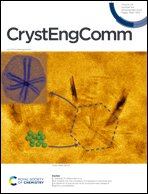Metal–organic framework (MOF)-derived hollow hybrid Cu2O/Cu/Au for non-enzymatic H2O2 sensing†
Abstract
The template-directed strategy is a facile and universal method to synthesize novel and useful functional materials that are difficult to achieve by traditional methods. Herein, a ternary hybrid Cu2O/Cu/Au with a hollow structure is synthesized via a two-step template-directed strategy. Hollow Cu-MOF-74 is selected as a self-sacrificial template and calcined under an Ar atmosphere to obtain hollow Cu2O/Cu with the preservation of the original hollow structure and rod-like shape. Then, hollow Cu2O/Cu acts as a self-sacrificial template as well as a reducing agent. The metal precursors are adsorbed on the surface of Cu2O/Cu and in situ reduced to Au nanoparticles, decorating the surface uniformly and forming the hollow ternary hybrid Cu2O/Cu/Au. More importantly, hollow Cu2O/Cu/Au is equipped with enhanced electrochemical catalytic activity toward the reduction of H2O2, which is ascribed to the introduction of Au nanoparticles facilitating electron transfer in the catalytic reaction, and it can be used as a candidate for an H2O2 sensor with high sensitivity, wide detection range and low limit of detection. Selecting suitable templates provides a new opportunity for constructing hybrids with novel structures.



 Please wait while we load your content...
Please wait while we load your content...